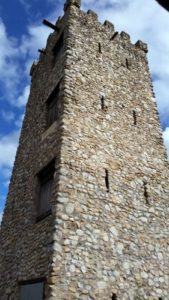Alphabetically, Brackenridge Park should be the next park up, but I’ve already covered Brackenridge Park here and here and here. So, skipping over Brackenridge, we get Cibolo Nature Center in Boerne, Texas.
We’ve been visiting Cibolo Nature Center since, oh, 2003 or so. I remember visiting it for the first time in the summer, and the sun was beating down on my hair pretty relentlessly (so that leaves out 2002; I didn’t have a whole lot of hair in the summer of 2002, I was still recovering from chemo). After the discomfort of the heat from the sun, I didn’t want to return again until fall. Once we went back, though, it didn’t take long to become one of my favorite parks, despite the half-hour drive it takes to get there.
The land which is now the Cibolo Nature Center was once just the back end of Boerne City Park (despite the name, there actually are other parks in Boerne). Prior to that, the land had been part of the ranch of Dr. Ferdinand Herff. A group formed to protect the section of Cibolo Creek that runs through this section of the park and also to preserve the little bit of wetlands that existed on the site. The city agreed that this was a worthwhile goal and the Cibolo Nature Center was established.
There are three miles of trails in Cibolo Nature Center,around two miles of which are named trails. These include the Marshland Trail, which leads out into the wetlands portion of the park, the Native Texas Prairie Trail, which leads out into the prairie at the center of the park, the Cibolo Creek Trail, which leads along Cibolo Creek, and the Woodlands Trail, which continues out into a wooded area farther along.
The Cibolo Creek Trail made me think of Middle Earth the first time I saw it, and it took me a while to realize why. The mass-market paperback edition of The Hobbit that was popular when I was young had Tolkein’s painting of the barrels with the dwarves in them escaping downstream and the view of the cypresses that line the banks lead to not a terribly different image.
They have at least in the past done controlled burns of the prairie area. This makes sense, because burning is an important part of prairie management. Without periodic burning, trees would eventually take over the land. Anyway, the now-ex, Alex, and I were in the prairie just after a burn once and we found something’s pelvic bones in the field. It seemed awfully small for a deer, but I’m nothing like an expert on osteology. At any rate, we didn’t want to disturb it, so we told one of the employees what we’d seen and where it was.
We had nicknames for most of the parks that we visited while Alex was young. The nickname that we had for for Cibolo Nature Center was “the dinosaur woods.” The “woods” part is pretty obvious, I think. The “dinosaur” part is one of the neatest things about the park. In 1997, there was tremendous flooding in this region. One of the side effects was that dinosaur footprints were exposed by the flooding near Boerne Lake. The city decided to preserve them by paving them over, from what I read, but prior to that, they made a cast of them and put the cast in the Cibolo Nature Center. It’s pretty easy to find the tracks from the parking lot. When you stand in the parking lot, you can see the pavilion (this is also where the restrooms are located). The path kind of skirts the pavilion and heads off to the right (as you look at it). The footprints are along that path.
The Marshland Trail is designed to be wheelchair accessible. The rest of the paths are largely pretty level, but unpaved. The path down to the creek itself is pretty steep and kind of rocky, so I’m not sure about getting too close to the creek in a wheelchair. I can only think of one staircase on the paths, and that leads up the side of the bluff between the Cibolo Creek Trail and the Woodlands Trail.

